From the Holy Blossom Temple Archives
From the HBT Archives: Rabbi Isserman and Immigration
Holy Blossom Temple Archives Committee

United Jewish Farmers of Ontario, Organization meeting, Holy Blossom Synagogue Toronto, March 25, 1925
Ferdinand Isserman was our rabbi from 1925 to 1929. The historical exhibition on immigration, currently on the second floor of our atrium in the Garson/Baskin Gallery, reminded us of Rabbi Isserman who, from the moment of his arrival in Canada, concerned himself with immigration and the plight of refugees.
Writing in the Canadian Jewish Review on September 4, 1925, Rabbi Isserman warned Canadians not to follow the example of the United States in adopting restrictive immigration laws. His advice was timely, as the U.S. Secretary of Labor, James J. Davis, was at the time visiting Toronto and urging Canadians to enact legislation similar to America’s restrictive Johnson Immigration Bill. Rabbi Isserman’s description of that law was blunt. He called it “a product of bigotry and chauvinism … It exalts the Nordic race, despite the fact that sober scientists maintain there is no Nordic race. It assumes a philosophy of racial superiority which has no basis whatsoever in objective truth.”
Sadly, as Rabbi Isserman would quickly learn, Canadian immigration policy was not much different from that of the U.S. Immigration from Britain was encouraged. Quotas for persons from other countries could be granted, at the discretion of the cabinet minister responsible for immigration, and these went mostly to Nordic countries. There was also a special category for farm labourers.
In December 1926, Rabbi Isserman, together with Lyon Cohen, a founder of the Jewish Immigrant Aid Society, and S.W. Jacobs and A.A. Heaps, Jewish members of Parliament from Montreal and Winnipeg, headed a delegation that met in Ottawa with the Minister of Immigration, Robert Forke. The group made two requests: that a quota for Jewish immigration be renewed and that concessions be made for the admission of relatives of Canadian Jews. Regulations at the time permitted a Canadian Jew to bring over an unmarried child or brother, but not a married child or brother or a sister. In January 1927, it was announced that both requests were refused.
This still left open the possibility for Jews to come to Canada as agricultural workers. A Jewish Farm School had been founded in Georgetown, Ontario. The school (which ran from 1925 to 1930) was the creation of the United Jewish Farmers of Ontario, whose first organizational meeting (see photo) was held at Holy Blossom in March 1925. Morris Saxe, under whose direction and on whose farm the school was to operate, was elected president and Rabbi Barnett Brickner, our rabbi from 1920 to 1925, was elected honorary president.
In an editorial in the Canadian Jewish Review on June 24, 1927, Rabbi Isserman wrote about the first immigrant arrivals at the school. “Fifty Polish war orphans, constituting the entire population of an orphanage in Mezrich, Poland, twenty-two girls and twenty-eight boys, from the ages of nine to seventeen, are en route to the Jewish Farm School …” Fundraising for the orphans, Rabbi Isserman reported was being led by Edmund Scheuer, well known as a distinguished member of our board, and for many years Superintendent of our religious school. Rabbi Isserman pleaded urgently for members of the Jewish community to assist Mr. Scheuer: “In five days the orphans will be here. Will you help provide for them? Will you be father to the fatherless and plead the cause of the orphan?”
You may wish to visit the Archives Committee displays in the Temple atrium honouring Rabbi Marmur z”l and The Pioneering Women of Holy Blossom, and the Living Museum display in the atrium in honour of Remembrance Day.
If you have any items of archival interest to contribute to the Holy Blossom archives, we would love to hear from you. Please email us at archives@holyblossom.org.




Leave a Reply
Want to join the discussion?Feel free to contribute!